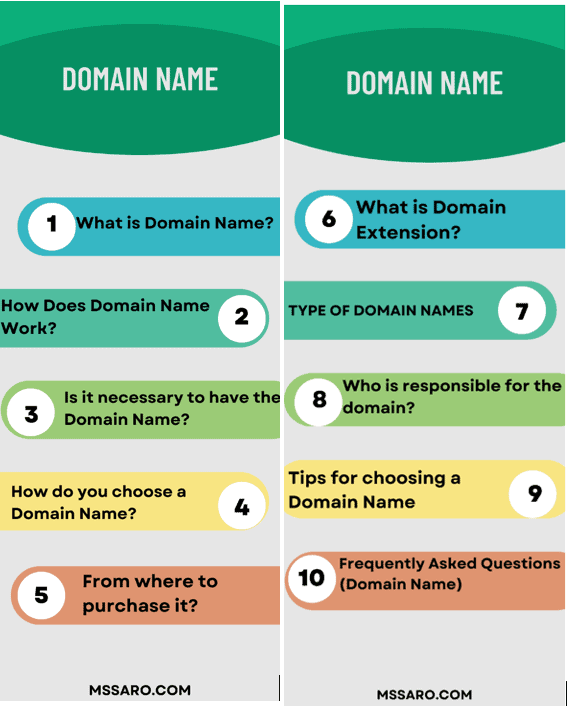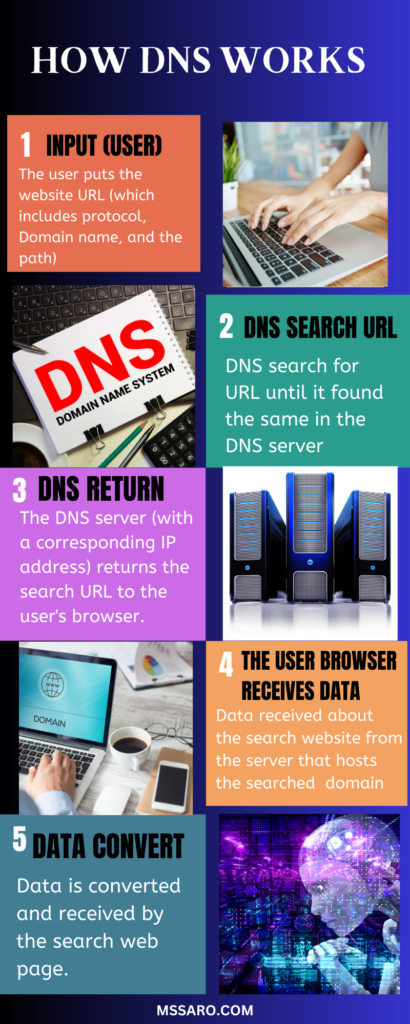As a beginner, you might be curious to know what is Domain name and how does it work?
Is it necessary to have a domain name?
How to choose the domain name? From where to buy it?
What are the types of Domain names, and who is responsible for the Domain name system?
In this beginner guide, I will cover all the Domain-related topics. So, stay glued!
If you are starting a website, you initially need two essential things:
Web hosting &
Domain name.
Here I am focusing on the domain name, for hosting read our blog on How to Choose Web Hosting Provider
What you would learn from this blog:

Table of Contents
ToggleWhat is Domain Name?
Your website name is the domain name. It is the address of your website where users can access your website.
The user won’t be able to reach your website without any address.
Before domain names, there was Internet Protocol (IP) addresses consisting of string numbers.
For every website, a different IP address and different sets of numbers so that they can easily connect.
Though remembering this set of numbers is complex, the word-based format solution comes as a domain name. These IP addresses are still attached to the domain name.
How Does a Domain Name Work?
When you write the URL (Uniform Resource Locator) of any website, the domain name will be present in the URL.
The internet transmits the same to the Domain Name System, i.e., DNS, which searches for the registered domain address (corresponding IP addresses are attached to the respective domain names).
And connects you with the URL you are searching for.
Difference between a Domain Name and a URL
The domain name is the website name, whereas the URL is the string that provides the website’s complete address. For example, my domain name is mssaro.com, and my website URL is https://mssaro.com
As you know, initially, there were only IP addresses by which your computer or mobile is connected to the internet.
These IP addresses are in the form of numbers connected to your device, so it’s become difficult to remember all the IP addresses.
So, these numbers have been assigned a specific domain name to ease the process. That means all the websites have IP addresses attached to their domain name.
Let me further explain to you.
You have many contact numbers in your phone, and you have saved these numbers by the name of the concerned person, so it is easy for you to dial the number.
Similarly, the Domain name system is a phonebook with all the registered IP address details.
Whenever you want to access any website, this DNS searches for a registered domain attached to a particular IP address.
DNS redirects these IP addresses to the respective domain name; thus, your searched website is loaded.
Infographics on How DNS Works

The process of DNS:
- Users search for a domain and type the URL of the search website.
- DNS search for the URL in its server and continue searching until it finds the domain name’s corresponding IP address.
- Then DNS returns to the IP address of the attached domain name the user searches for.
- The user browser received the data from the host server of the domain.
- Finally, the user receives data through the search web page.

The user input the desired URL, which includes the domain name of that particular website. The Domain Name System (DNS) is the registered domain’s phonebook search for the desired web page.
And if the corresponding IP address of that domain is not found in one server, they search for it in another server and keep on searching until the address is found.
As the address (registered domain name) is found, it returns the information to the receiver. Thus, the user’s desired page is loaded.
Difference Between HTTP and HTTPS
| HTTP | HTTPS |
| Hypertext Transfer Protocol, enabling communication between systems. | Hypertext Transfer Protocol Secure, enabling secured communication between systems. |
| The URL would begin as http:// | The URL would begin as https:// |
| It does not provide security of data. | It ensures the security of data |
| It does not have SSL Certificate, so there is no secure protocol | Https has a Secure Sockets Layer (SSL). It required SSL/TLS Certificate |
| It works on the Application Layer | It works on Transport Layer |
| Encryption is absent. | Encryption is present |
| It does not improve search ranking | It does not improve search ranking. |
| Not Good for SEO | Better SEO advantages |
SLD (Domain Name) and TLD (Domain Extension)– SLD is the second-level domain, referred to as domain name.
For example, mssaro.com here, mssaro is the second-level domain, and TLD is the top-level domain here .com is the domain extension.
Is it necessary to have a Domain Name?
Yes, without a domain name, nobody would reach your website. So, it becomes essential to have this; it would give your website a professional look and establishes your brand.
How to Choose a Domain Name?
The domain name includes extensions like .com, .in,.net, .edu, .org, and many more.
For example, I have a website named https://mssaro.com
here, https is the protocol (SSL certificate),
mssaro is the name of my website, i.e., my website domain name,
and .com is the domain extension.
Domain name depends upon your business;
if your website is for commercial purposes, you should take the .com domain extension;
if the website is for education, then .edu;
if it is an organization website, then .org is the best suited,
and .gov is for the government.
The Domain names are also country-specific like .in is for India, .uk is for the United Kingdom, etc.
List of some domain names
| Domain Extension | Usage |
| .com | Commercial |
| .edu | Education |
| .gov | Government |
| .org | Non-profit organization/non-governmental organization/online communities |
| .net | Internet Service providers/Networks |
| .info | Extension short form of information |
| .in | India |
| .ca | Canada |
| .uk | United Kingdom |
| .us | United State |
| .du | Germany |
| .cn | China |
| .jp | Japan |
The top domain name is .com which, as per domainnamestat.com, is around 36.99%.

Source: Overview | Domain name registration statistics (domainnamestat.com)
What are Domain Extensions?
The domain extension is the letters at the URL’s end after any website name. Many domain extensions like .com, .in, .edu, .org, .net, and others exist.
You can quickly check the domain name availability with the help of a domain checker. Remember, you can take the desired domain name only if it is available and not taken by others.
Types of Domain Names
- Generic Top-level Domains-These are the non-country top-level domains for some specific use. It includes .com, edu, .net, and .gov. For example, the generic top-level domain is for commercial use .com, for educational .edu, and government uses .gov
- Country code top-level domain (ccTLD)– It shows where the company is registered; for the United Kingdom, it is .uk; for India, it is .in; and for Japan, it is .jp
Where to Buy Domain Name
A domain name can be brought from any domain name registrar. Some famous company that gives domain name are
- GoDaddy,
- Namecheap,
- Hostinger,
- Domain.com, etc.
I will recommend you take the domain name along with web hosting, as a domain name is free for 1 year if you purchase it along with hosting.
The best web hosting providers which give domain names free for 1 year are
Bluehost hosts my website, and I am a delighted customer of Bluehost.
Who is Responsible for the Domain
The registrar manages the domain name. Internet Corporation for Assigned Names and Numbers (ICANN) controls registries of domains. ICANN maintain and manage all domain names along with their IP addresses.
Tips for Choosing a Domain Name
- Take a short and unique domain name.
- It should be easy to spell and pronounce.
- Avoid numbers and hyphens in the domain name.
- Try to use a keyword that shows what your website is about.
- Register your domain name.
- Take domain extensions which are top-level domain extensions like .com, .org, or .net
Final Thought
The domain name is essential to remember while starting your website.
It should be unique and simple so people can easily relate to your website.
Search the domain availability with the help of a domain name checker and decide on your website name accordingly.
If you have decided to start a website so instead of purchasing a domain name separately, buy your hosting. The domain name comes free for one year with hosting like Bluehost, Dreamhost etc
Contact me for more queries and understanding regarding domain name or hosting.
Do share with me your unique & simple ideas for domain names and what type of website you are planning to start.
I would be happy to help you. Stay in touch!
Keep Smiling and Start Sharing!
Frequently Asked Questions on Domain Name
Answer: Domain name is the website address we type at URL to reach that particular website; in my case, mssaro.com is my domain name. So whenever anyone types mssaro.com, they will easily reach my website pages. We need a domain name and hosting space for running any website. Hosting is the space where the website files are stored and are available for worldwide users; in my case, my website hosting company is Bluehost. So, all my website files are stored in the secured area of the Bluehost server for worldwide viewing.
Answer: Domain name is the website address and URL; the Uniform Resource Locators is a string of information for completing any website web address.
Answer: Yes, both are different. URL is Uniform Resource Locator, a complete web address of any website. DNS is a Domain Name System, a repository of all the domain names and the corresponding IP address of all the URLs.
Answer: URL consists of the protocol, domain name including TLD, and the path leading to a specific page. For example:
https://mssaro.com/blogging
Here, https is the secured protocol, Domain name +TLS is mssaro.com, and blogging is the path to a specific page.
Answer: Domain transfer is changing your domain registrar. For changing your registrar, ICANN enforces a 60-day lock period.
Answer: A 60-day lock period should be over as per ICANN eligibility—points to be considered for transferring the domain.
1. Update your contact information, as the registrar would need the same for transferring your process.
2. Unlock your domain
3. Go to your web hosting and initiate the transfer
4. Authorize your domain transfer
5. Open an account with a new registrar
6. Finalize your domain transfer
Answer: Transferring a domain would take at least 7 days if all information is as required.
Question: Yes, it is possible to buy more than 1 domain name if your business type requires the same.
Answer: Yes, you can change your domain name. But it would be fearsome to do so for bloggers, as they get scared of losing all content and traffic too. Though don’t be nervous, there is a possibility to do so. The essential tips to do so are:
1. Consider whether your old domain system has an easy migration policy. If yes, good for you, go ahead. If not, then have both domains until the migration process is done.
2. Tell your hosting company about the domain name change by going to its admin setting section.
3. Go for 301 redirects and enter the new domain name and redirect location.
4. Always tell Google about new changes by submitting your sitemap.





